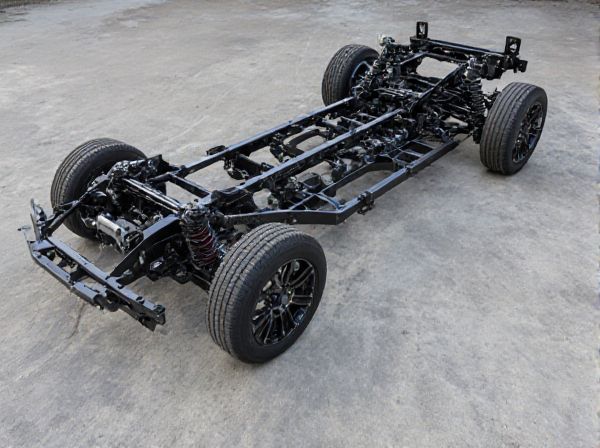
Photo illustration: Central Spine Chassis vs Floorpan Chassis
Central spine chassis offer enhanced rigidity and improved handling by concentrating the structural strength along a central backbone, making them ideal for sports and performance cars. Floorpan chassis provide a flat, wide base that increases interior space and structural integrity, commonly used in mass-produced vehicles for better comfort and safety. Your choice depends on whether you prioritize driving dynamics or passenger space and practicality.
Table of Comparison
| Feature | Central Spine Chassis | Floorpan Chassis |
|---|---|---|
| Structure | Single central beam running the car length | Flat, wide platform forming the vehicle's base |
| Weight Distribution | Concentrated along center spine for rigidity | Evenly spread across floor for stability |
| Strength & Rigidity | High torsional rigidity with minimal flex | Strong but generally less rigid than spine chassis |
| Manufacturing Complexity | Moderate; simpler design with fewer parts | High; requires large stamped panels and welding |
| Crash Safety | Good energy absorption through spine deformation | Superior crash management via crumple zones |
| Application | Sports cars, niche vehicles needing stiffness | Mass-market cars, SUVs, electric vehicles |
| Cost | Lower production cost due to simpler chassis | Higher cost driven by complex assembly |
Introduction to Central Spine and Floorpan Chassis
Central Spine Chassis features a robust central backbone that enhances torsional rigidity and structural integrity, commonly used in sports and high-performance vehicles. Floorpan Chassis integrates the vehicle's floor structure as a key load-bearing element, optimizing weight distribution and manufacturing efficiency in mass-produced cars. Comparing these designs highlights differences in stiffness, weight savings, and vehicle dynamics, crucial for automotive engineering and chassis design.
Structural Overview: Central Spine Chassis
The Central Spine Chassis features a robust central backbone that runs longitudinally through the vehicle, providing exceptional torsional rigidity and impact resistance. This design centralizes the load distribution, enhancing structural integrity while allowing for lightweight construction and better handling dynamics. Engine and suspension components are typically mounted directly onto this spine, optimizing space and improving overall vehicle balance.
Structural Overview: Floorpan Chassis
The floorpan chassis features a flat, wide base that serves as the primary structural element, distributing loads evenly across the vehicle's underside for enhanced rigidity and crash protection. It integrates the floor, side rails, and cross members into a cohesive unit, optimizing weight distribution and improving passenger safety during impact. This design supports modular assembly and facilitates incorporation of advanced suspension systems, making it prevalent in modern passenger cars and electric vehicles.
Key Differences Between Chassis Types
Central Spine Chassis features a prominent structural beam running through the vehicle's center, enhancing rigidity and impact absorption, while Floorpan Chassis relies on a flat, wide base for structural support and load distribution. Central Spine designs provide superior torsional stiffness and are commonly used in sports or high-performance vehicles, whereas Floorpan Chassis emphasizes space efficiency and ease of manufacturing, frequently found in mass-produced cars. The fundamental difference lies in the load path and structural framework, impacting handling characteristics and crash safety ratings.
Advantages of Central Spine Chassis
Central Spine Chassis offers superior torsional rigidity and enhanced crash protection compared to traditional Floorpan Chassis, making it ideal for performance and safety-critical vehicles. Its design centralizes structural loads along a reinforced spine, reducing overall vehicle weight while improving handling precision and stability. This chassis type also facilitates easier integration of powertrain components and optimizes interior space for passengers and cargo.
Advantages of Floorpan Chassis
Floorpan chassis offers superior structural rigidity and enhanced crash safety by distributing impact forces evenly across the vehicle's base. This design improves passenger comfort through better vibration absorption and chassis flexibility. Manufacturing efficiency is increased due to simpler assembly processes, reducing production costs and enabling easier integration of various vehicle components.
Performance and Handling Comparison
Central Spine Chassis delivers superior torsional rigidity and weight distribution, enhancing cornering stability and precision steering response. Floorpan Chassis offers a broader base, improving low-speed maneuverability and ride comfort by absorbing road irregularities more effectively. Performance analysis indicates Central Spine Chassis excels in high-performance sports cars due to stiffness, while Floorpan Chassis favors everyday vehicles for balanced handling and smoother driving dynamics.
Safety and Crashworthiness Considerations
Central spine chassis design enhances crashworthiness by distributing impact forces along a reinforced central beam, reducing cabin deformation and improving occupant protection during frontal crashes. Floorpan chassis structures offer increased rigidity and lower center of gravity, contributing to better stability and energy absorption in side impacts but may allow more intrusion in high-severity collisions. Safety considerations prioritize the central spine chassis for superior crash energy management, while floorpan chassis designs benefit from advanced crumple zones and structural reinforcements to optimize passenger safety.
Applications in Modern Automotive Engineering
Central spine chassis offer superior torsional rigidity and lightweight properties, making them ideal for high-performance sports cars and electric vehicles requiring enhanced structural integrity and battery packaging efficiency. Floorpan chassis provide extensive space optimization and modularity, commonly used in mass-production sedans and SUVs where cost-effectiveness, repairability, and passenger safety through integrated crumple zones are critical. Both chassis types influence vehicle dynamics, manufacturing complexity, and crash performance, with central spine designs prioritizing stiffness and floorpan frameworks focusing on versatility and occupant protection.
Choosing the Right Chassis for Specific Vehicles
Central Spine Chassis offers superior torsional rigidity ideal for high-performance sports cars and lightweight vehicles, enhancing handling and stability. Floorpan Chassis provides a flat, expansive base favored in sedans and SUVs for maximizing interior space and structural integration. Selecting the right chassis depends on vehicle purpose, with central spine excelling in agility and floorpan prioritizing comfort and safety.
 caratoz.com
caratoz.com